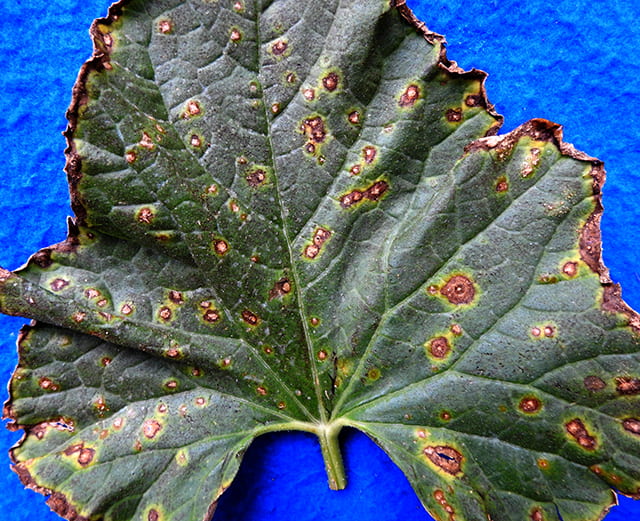This disease has been seen rarely on Long Island. It is not considered an important disease of cucurbits, but can cause defoliation resulting in yield loss when left unmanaged especially during rainy periods or where overhead irrigation is used.
Leaf spots start as small, water-soaked to brown, circular spots about ¼ inch in diameter and develop a brown border and yellow halo plus target-like pattern of rings in the spot as it enlarges. Symptoms do not occur on stems or fruit.
The pathogen can be seed-borne and it can survive in crop debris. Incorporate crop debris as soon as possible after harvest. First mow or flail chop to break up the debris to hasten decomposition. Minimum two-year rotation out of cucurbits is recommended. All cucurbits are susceptible but netted melons are most susceptible. Chlorothalonil and mancozeb are good protectant fungicides. Targeted fungicides to use when this disease is found include Aprovia Top, Inspire Super, Endura, and FRAC code 11 fungicides (Cabrio, Quadris, Pristine). Spores of Alternaria fungi are dispersed by wind, but being much larger than those of mildew fungi, they are not able to move far and thus farm to farm spread is uncommon.
Please Note: Fungicides mentioned are for use in commercial production, not gardens. The specific directions on pesticide labels must be adhered to — they supersede these recommendations if there is a conflict. Any reference to commercial products, trade or brand names, is for information only; no endorsement is intended. For up-to-date information on labeled conventional fungicides see Cornell Integrated Crop and Pest Management Guidelines for Commercial Vegetable Production and biopesticides see the Biopesticides website.








